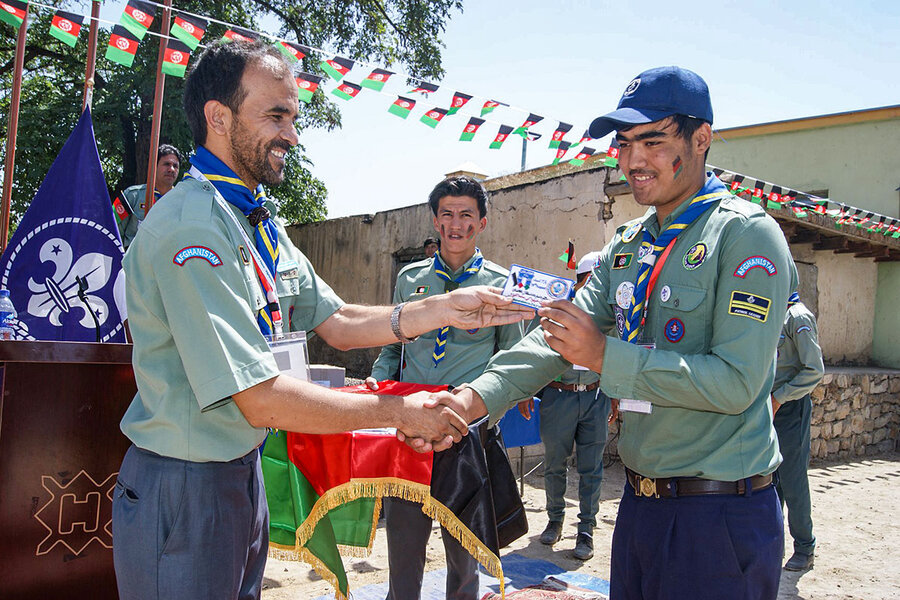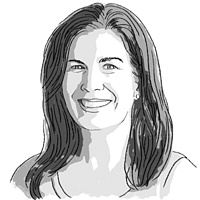They found hope in Afghanistan. Now they strive to preserve it.
Loading...
| SEATTLE
She is the daughter of an American biology instructor, and spent an idyllic childhood exploring Kabul under a peaceful monarchy in the late 1960s, when her father taught in Afghanistan.
He is the son of an Afghan army officer, and grew up amid the turmoil of the 1980s Soviet occupation, civil war, and then Taliban repression.
For the past decade, on the outskirts of Kabul, Marnie Gustavson and Mohammad Tamim Hamkar have worked together on a rural compound surrounded by almond and peach orchards, quietly running a small nongovernmental organization that has transformed the lives of thousands of poor Afghan girls and boys through leadership training and community service.
Why We Wrote This
A story focused onMarnie Gustavson and Mohammad Tamim Hamkar have worked together for a better Afghanistan, training youths for leadership and community service. Now they face a new challenge.
But in August, the dream they pursued together suddenly took a nightmarish turn. As Taliban militants emboldened by the sudden departure of Western military forces captured one major city after another over the span of days – rapidly surrounding the Afghan capital – Mr. Hamkar felt overwhelmed by sadness. He looked over at Ms. Gustavson, her face registering a similar dread.
“What is going on in this country?” Mr. Hamkar said, his voice shaking as they cried together. “What should we do?”
His question hung in the air, as the shock of the uncertainty they faced sank in. There were, they both knew, no easy answers.
Nevertheless, it wasn’t long before Mr. Hamkar vaulted into action.
“Adventure around every corner”
For Ms. Gustavson, the journey that brought them to that moment began with her embrace of the tightly knit Afghan culture as a preteen and teen in 1960s Kabul.
“There was a close community, an adventure around every corner,” she recalls. Her family had no television. They had a phone, but she didn’t know the number. “We entertained ourselves,” she says.
Yellowing photos from a family album capture her perusing cloth in a crowded bazaar, climbing around ancient ruins and flag-festooned graveyards, and sitting in a courtyard in her plaid skirt and black tights listening to village musicians.
What she learned to love most was the conversation. “Afghans are wicked funny people,” she says.
That fondness led her to return to Afghanistan to live in 2004, after a long absence during which she raised her own family and established a career running nonprofit organizations in the United States. Back in Kabul, she volunteered at PARSA, a small nonprofit aiding impoverished Afghan women, children, and orphans.
Stanford-educated physical therapist Mary MacMakin had founded PARSA in 1996 under Taliban rule, and ran several secret schools for women. The Taliban briefly jailed and then expelled Ms. MacMakin, but after the U.S.-led military invasion overthrew the Taliban in 2001, she returned to Kabul.
In 2006, she asked Ms. Gustavson to take the helm of PARSA. Under her leadership, PARSA has expanded its mission of building healthy communities and increased its annual funding more than tenfold.
In 2008, PARSA moved onto the large, semirural compound of the Afghan Red Crescent Society (ARCS), which includes a traditional Afghan refuge – a marastoon, or place of help – that had been created in the 1930s for destitute widows, orphaned children, and disabled people. With a staff of 120, PARSA helps many of the marastoon residents as part of its wide-ranging programs.
“It’s like a village,” says Ms. Gustavson, who was living in a nearly 100-year-old ARCS house that was rebuilt from ruins, surrounded by a community of some 300 people as well as cows, horses, and fields. “I am with people all day long.”
A major advance came in 2010, when Mr. Hamkar joined PARSA with the goal of reviving Afghanistan’s beleaguered scouting program. Dating back to 1931, scouting in Afghanistan experienced several incarnations, growing to 36,000 members before it came to a halt after the Soviet Union invaded in 1979.
Commitment to scouting
Growing up in Baghlan province north of Kabul in the 1990s, Mr. Hamkar had learned to adapt as his family’s fortunes fluctuated under changing Afghan regimes – picking up farming, greenhouse agriculture, and business skills at a young age.
“I started my private business, an ice cream shop,” while still in high school, he says.
Such life experiences helped him appreciate Boy Scout merit badges, but it was in college, at Kabul Polytechnic University, that Mr. Hamkar discovered the power of scouting as a vital part of youth education.
“All these activities are supporting young people in learning leadership, honesty, citizenship,” and hard work, he says.
At PARSA, Mr. Hamkar found in Ms. Gustavson someone who could share his dream. One day, he took her aside and asked for her pledge – to build a sustainable, long-term scouting program.
“Scouting is not a project to start one year and stop the next. I am not doing this,” he told her. “We must make a program. Can you promise me?”
She agreed.
Ten years later, with PARSA’s help, Afghanistan had trained 600 scoutmasters and had nearly 11,000 active scouts in 34 provinces. In 2020, it regained its membership in the World Organization of the Scout Movement. “I was very happy,” says Mr. Hamkar.
Their shared vision of empowering youth to take the initiative and serve their communities – by planting trees, digging wells, installing libraries, and other projects – has spread hope, they say. The scouts “are highly motivated and quite independent ... which is not Afghan tradition,” says Ms. Gustavson.
Indeed, colleagues say Ms. Gustavson stands out as an NGO leader for nurturing boldness in both her staff and Afghan youth.
“Marnie encouraged them to be outspoken leaders, which is not typical,” says Mark Ward, a retired senior U.S. diplomat and former country director in Afghanistan for International Medical Corps.
“They hear my voice”
From her mud-brick home on the side of a mountain overlooking Kabul, Zohra, an Afghan scout, walks for an hour to fetch water to help sustain her family of 10 people. After Zohra’s father died, her mother and siblings, then considered orphans, moved into the marastoon near PARSA eight years ago to escape starvation.
Today Zohra, who is using a pseudonym for her protection, credits PARSA for believing in her, and helping her realize her own potential. “PARSA is a place where they hear my voice, and they respect me as a human,” she says by phone from her mountainside home.
A competitive long-distance runner, straight-A high school senior, fluent English speaker, and leader in training other local youth, Zohra helps support her family while her mother works, caring for the marastoon’s mentally disabled residents for $80 a month.
“Marnie is like my mother,” she says. “She helped me and so many orphans to have facilities to learn, to set goals for ourselves, and to have hope for the future.”
Mobilized youth
After his tearful meeting with Ms. Gustavson in August, Mr. Hamkar had an idea. He rallied Zohra and other scouts, and gathered up tents, sleeping bags, blankets, and camping gear.
Thousands of Afghans fleeing the Taliban advance were huddling in Kabul in the hot sun without water and other basic supplies. The scouts sprang into action, setting up a protected village with 60 tents in a local park. Within hours, the scouts were caring for 45 families, providing food, water, toilets, and first aid, and ensuring the village was safe.
“There was no fighting, no stealing – the camp was supervised by the scouts,” says Mr. Hamkar.
For a week, the scouts cared for hundreds of displaced people, but on Aug. 15, a Sunday, the Taliban swept into Kabul, forcing the young volunteers to pull back.
Taliban fighters overran PARSA’s compound, stealing three trucks and temporarily detaining a staff member. Meanwhile, Ms. Gustavson had made the wrenching decision to evacuate for her safety, boarding the last commercial flight out of Kabul for Dubai just a few hours before.
Mr. Hamkar was stunned by the collapse of the Afghan police and army. “Everything changed in front of my eyes in six hours,” he says in a call from Kabul.
After lying low for two days, he returned to PARSA, only to have the Taliban arrive and demand he take them alone into his office. Two men in black turbans questioned him, while a third stood at the door with a U.S. military rifle.
“Tell me the truth!” the oldest of the Taliban said. “We found you are teaching Christianity!”
Mr. Hamkar, knowing the Taliban ways, says he stood strong, and let out a loud laugh.
“Who told you we are doing this illegal activity against Islam?” he demanded back, adding that PARSA’s staff has 119 Muslims and one non-Muslim, Ms. Gustavson. “How is this possible?”
The Taliban backed down, he says, and within days, Mr. Hamkar had obtained an official letter allowing PARSA to remain open.
Seeking a path forward
In the modern, street-level office of her sister’s West Seattle town house, with its gleaming windows and cold, concrete floors, Ms. Gustavson seems out of place in her earthy maroon tunic and dangling blue lapis earrings. Three weeks after she fled Kabul, she feels dislocated, too.
“I am not functioning that well here yet,” she says, staying up most nights on calls to Afghanistan.
Mr. Hamkar understands. “She is physically in the U.S., but emotionally she is always here,” and eager to return, he says. “I told her, ‘Please, Marnie, don’t hurry; everything is still unclear.’”
Frustrated by the intense focus on evacuations, Ms. Gustavson says PARSA is concentrating on humanitarian aid for the people left behind. Knowing the Taliban needs its help, a coalition of NGOs including PARSA is pressing them to allow women to work.
Mr. Hamkar, meanwhile, faces the challenge of explaining scouting to the mullah in charge of the education ministry, in a bid to gain permission for it to continue. “We had a dream for this country,” he says, his voice trailing off. “I am sad and very, very tired.”
For her part, Zohra stays close to home, restrained by the Taliban’s ban on sports and school for teenage girls. But far from giving up, she exercises daily indoors. And she has quietly started teaching English and public speaking to other homebound young women.
“We are still trying,” she says, “and we are still alive.”









